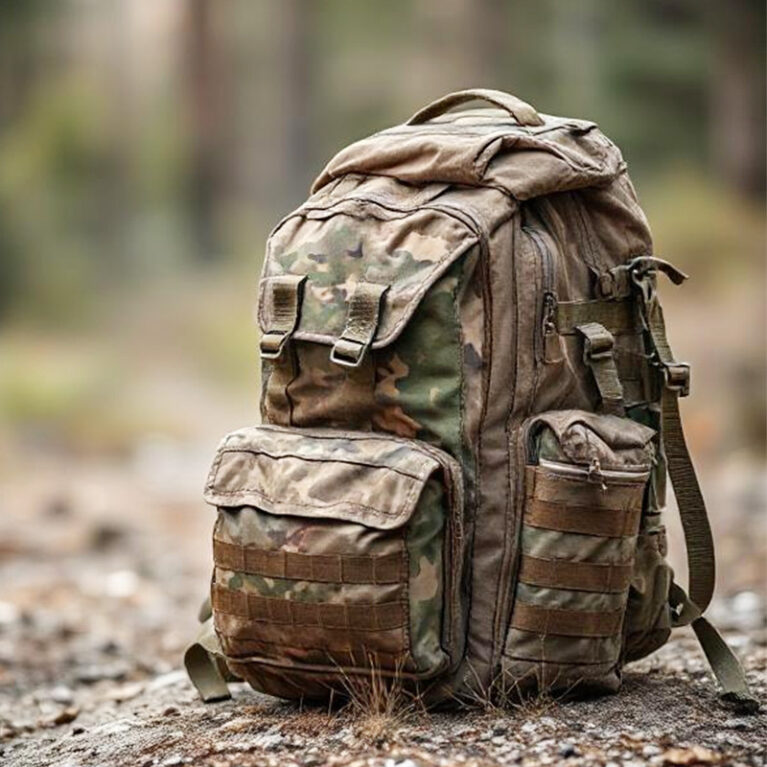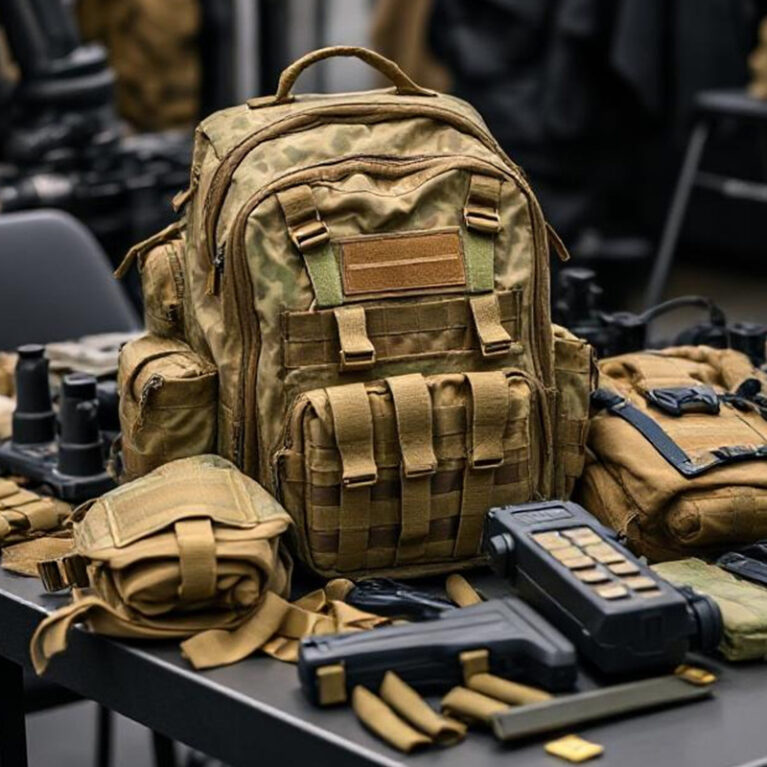Tactical backpacks are known for their ruggedness, versatility, and military-inspired designs. Whether you are an outdoor adventurer, a tactical expert, or looking for a reliable everyday backpack, these backpacks are built to handle demanding environments. However, with so many options to choose from, it’s easy to feel overwhelmed.
To help you navigate tactical backpacks, I compiled the 10 most common questions about backpacks. From size and materials to features like MOLLE systems and waterproofing, this article will provide clear answers to your decision-making process. Let’s get started!
1. What sizes do tactical backpacks come in? How do I choose the right size?
Tactical backpacks come in a variety of sizes, usually categorised as small (10L-30L), medium (30L-50L) and large (50L+).
How to choose a backpack size? You should consider your needs and the duration of your activity. If you need mobility and light weight, choose the smaller size. For multi-day trips or tactical missions, choose the 30L-50L. If you need to carry bulkier gear or survival equipment, the 50L+ is your best choice.
| Size (Liters) | Category | Best For |
| 10L-20L | Small | Everyday Carry (EDC), commuting, light travel |
| 20L-30L | Compact | Day hikes, short trips, urban tactical use |
| 30L-40L | Medium | Multi-day hikes, military missions, bug-out bags |
| 40L-50L | Large | Extended outdoor trips, survival prep, heavy loads |
| 50L+ | Extra Large | Long expeditions, heavy gear, tactical operations |
2. What materials are tactical backpacks usually made of? How do I choose the right material?
Tactical backpacks are usually made from nylon or polyester in 600D, 800D or 1000D fabrics for durability, and Cordura nylon is a quality option known for its abrasion resistance. Some models also have waterproof coatings such as PU (polyurethane) or Teflon for added protection.
Different materials meet different needs: 600D polyester is lightweight and affordable, perfect for casual use. 800D-1000D nylon offers greater durability in harsh environments. For maximum strength and water resistance, Cordura nylon is the best choice. For extreme wet conditions, you can choose a pack with a waterproof liner or rain cover.
| Material | Denier (D) | Key Features | Best For |
| Polyester | 600D | Lightweight, affordable, water-resistant | Casual use, light outdoor activities |
| Nylon | 800D-1000D | Durable, abrasion-resistant, water-resistant | Hiking, military, survival gear |
| Cordura Nylon | 1000D+ | Ultra-durable, tear-resistant, premium quality | Military, extreme conditions |
| Ripstop Nylon | 500D-1000D | Lightweight, tear-resistant, reinforced weave | Outdoor, tactical missions |
| Ballistic Nylon | 840D-1680D | Heavy-duty, extremely tough, impact-resistant | Military, law enforcement |
| Kevlar Blend | Varies | Cut-resistant, fire-resistant, ultra-strong | Specialized tactical use |
3. What do 600D, 800D, and 1000D mean in tactical backpacks? How do I choose the right Denier?
600D, 800D and 1000D refer to denier (D) and are used to measure the thickness and durability of a fabric. The higher the denier, the stronger and more abrasion-resistant the material, but the weight and stiffness also increase.
You can choose according to your needs: 600D for casual use, 800D for multi-purpose use and 1000D for extreme durability. If water resistance is important, look for PU or Teflon coatings.
| Denier (D) | Strength | Weight | Best For |
| 500/600D | Medium | Light | Everyday Carry (EDC), casual use, light outdoor activities |
| 800D | Strong | Moderate | Hiking, tactical missions, moderate outdoor use |
| 1000D | Very Strong | Heavy | Military, survival, rugged environments |
| 1200D+ | Ultra-Durable | Very Heavy | Extreme conditions, high-impact activities |
4. How much do tactical backpacks weigh? How do I choose the right weight?
The weight of a tactical backpack varies by size, material and function. General:
You should make your choice based on carrying capacity and purpose. If flexibility is key, choose a lighter pack. If you need durability and load support, a heavier, well-padded pack is better. For longer journeys, make sure there is weight distribution and comfort features such as adjustable shoulder straps and waistbelt.
| Size (Liters) | Weight Range | Best For |
| 10L-20L | 1-2 lbs (0.5-1 kg) | Everyday Carry (EDC), commuting, short trips |
| 30L-40L | 3-4 lbs (1.5-2 kg) | Day hikes, tactical missions, bug-out bags |
| 40L-50L | 4-5 lbs (2-2.5 kg) | Multi-day trips, survival gear, heavy loads |
| 50L+ | 5-7+ lbs (2.5-3.5+ kg) | Long expeditions, military use, rugged conditions |
5. What colors do tactical backpacks come in? How do I choose the right color?
Tactical backpacks come in a variety of colours, each with a different purpose:
If you need stealth, choose black or grey. For outdoor and military use, OD Green, Coyote Brown or Camouflage work best. If you want a mix of tactical and casual uses, grey or tan is a good balance.
| Color | Best For | Key Features |
| Black | Urban use, law enforcement, everyday carry (EDC) | Discreet, versatile, professional look |
| Coyote Brown / Tan | Military, desert environments, outdoor use | Blends well in dry and arid areas |
| OD Green (Olive Drab) | Military, survival, hiking, forest environments | Classic tactical color, natural camouflage |
| Multicam / Camouflage | Military, hunting, tactical operations | Best for concealment in varied terrain |
| Gray / Wolf Gray | Urban, covert tactical use, casual wear | Low-profile, tactical yet non-military look |
6. Are all tactical backpacks waterproof?
Not all tactical backpacks are fully waterproof, but most are water-resistant. Water-resistant backpacks can handle light rain and splashes, but won’t keep contents dry in heavy rain or submersion.
For better protection, you should look for backpacks made of coated nylon (e.g., 500D-1000D nylon with PU or Teflon coating). Sealed zippers and welded seams also improve water resistance. If you need full waterproofing, choose dry bags or backpacks with roll-top closures.
To protect your gear, you can use a rain cover or waterproof liners inside your pack. If you’re in extreme wet conditions, investing in a fully waterproof tactical backpack is the best choice.
7. What is MOLLE on a tactical backpack?
MOLLE (Modular Lightweight Loadspace Equipment) is a webbing system sewn onto tactical backpacks that allows users to attach compatible packs, gear and accessories. It offers customisation and expandability and is ideal for military, law enforcement and outdoor enthusiasts.
MOLLE webbing is made of strong nylon and typically follows a 1-inch horizontal pitch with reinforced stitching. This system allows the user to securely mount additional gear such as water bottle holders, first aid kits, ammo pouches or tools.
When choosing a MOLLE backpack, you should consider your gear needs. If you need versatility and quick access to your gear, then a MOLLE-compatible backpack is a great choice for tactical, survival or outdoor missions.

8. What features should I look for in a tactical backpack?
Choose based on your needs—for EDC, a compact design works best, while long trips require larger capacity. Prioritize features that enhance efficiency and ease of access in your specific environment. Here are some tactical backpack features for your reference as below:
| Feature | Benefit |
| Durable Material (500D-1000D Nylon, Cordura) | Increases longevity and resistance to wear & tear |
| Water Resistance / Waterproofing | Protects gear from rain and moisture |
| MOLLE Webbing | Allows attachment of extra pouches and gear |
| Multiple Compartments & Pockets | Enhances organization and quick access to essentials |
| Hydration Bladder Compatibility | Enables hands-free drinking during outdoor activities |
| Padded Shoulder Straps & Waist Belt | Improves comfort and weight distribution |
| Reinforced Stitching & Heavy-Duty Zippers | Adds durability under heavy loads |
| Ventilated Back Panel | Reduces sweating and improves airflow |
| Expandable Design | Adjusts capacity for different load needs |
| Lockable Zippers | Provides extra security for valuables |
9. How can I find tactical backpacks near me?
You can check out your local outdoor gear shop, military surplus shop, or tactical gear retailer. Many of these shops carry a variety of tactical backpacks. You can also search for local tactical gear dealers or visit shopping centres with outdoor or adventure sections.
What's more, you can use an online shop locator or search on platforms like Google Maps to find nearby shops. You can also check e-commerce sites like Amazon, which may have in-store pickup options. If you prefer customisation options, some tactical manufacturers offer direct sales through showrooms or trade shows in your area.
10.How do I pack a tactical backpack?
To pack a tactical backpack, start by organising your gear. Place heavier items (such as sleeping bags or water bottles) at the bottom for better weight distribution. This will help balance the load and make the pack more comfortable to carry.
Next, place light, frequently used items (such as snacks, a torch or first aid kit) in the top compartment or in easily accessible pockets. Use MOLLE webbing to secure small items or gear you may need to access quickly. Roll or compress clothing and extra gear to maximise space and minimise creases. Finally, make sure your hydration pack is filled and properly secured in its compartment. Tighten all the straps and adjust the hip belt to distribute the weight evenly. This will ensure you have comfortable and efficient access to your essentials.
Read more: How to Pick a Tactical Backpack: Insights from an Italian Designer








